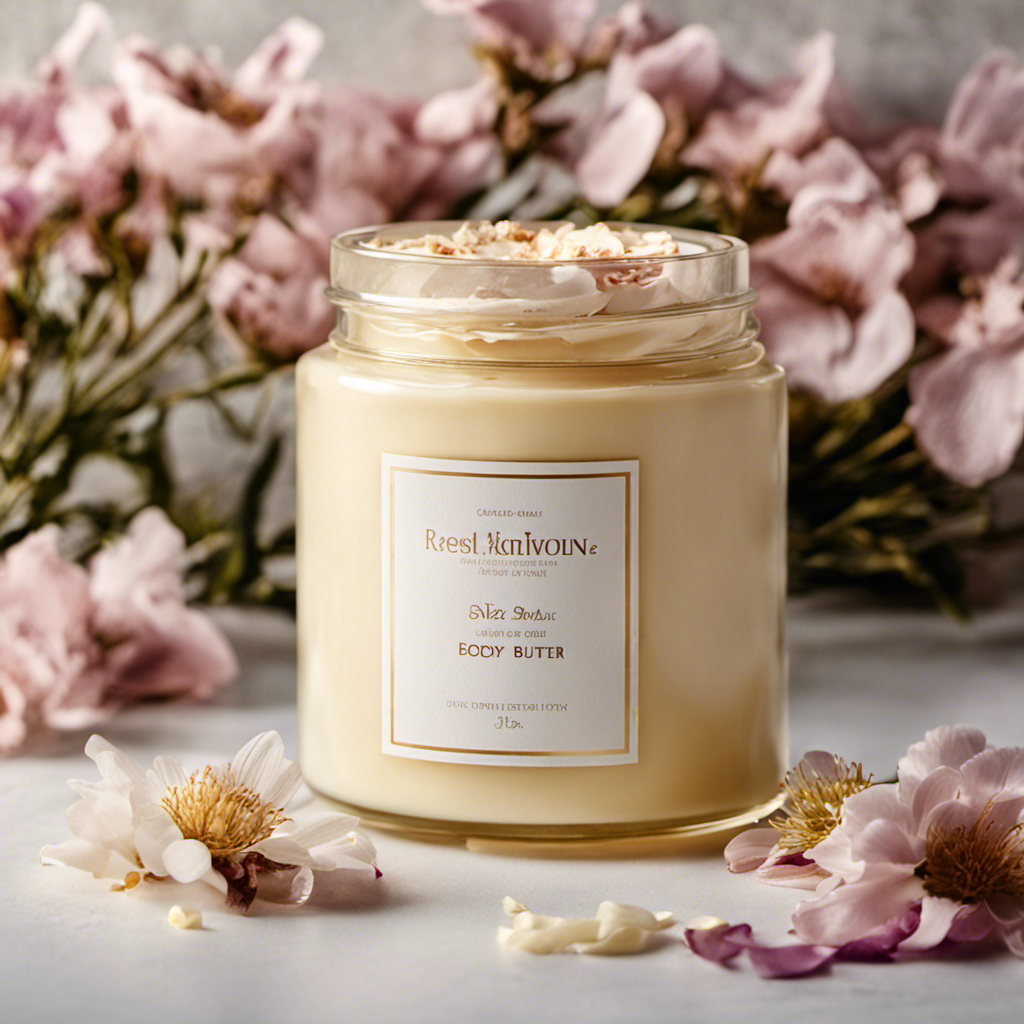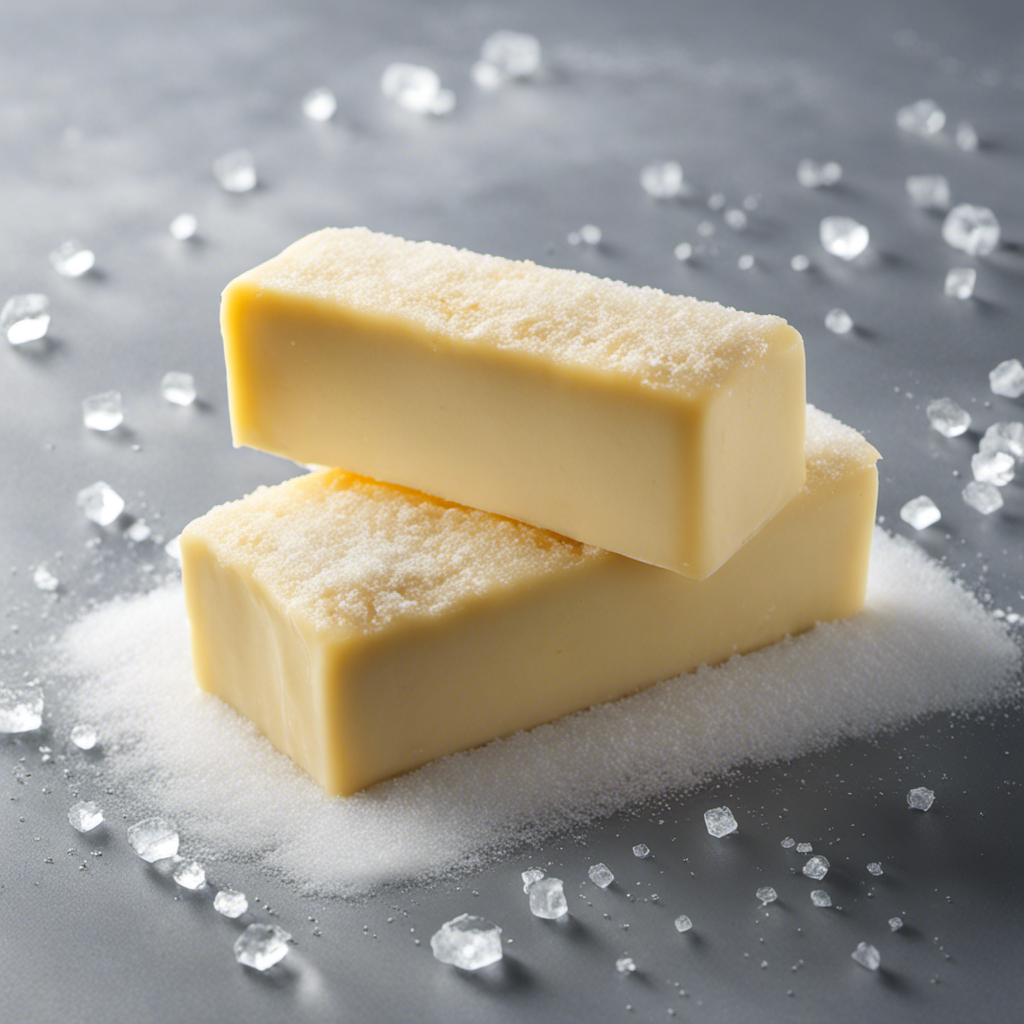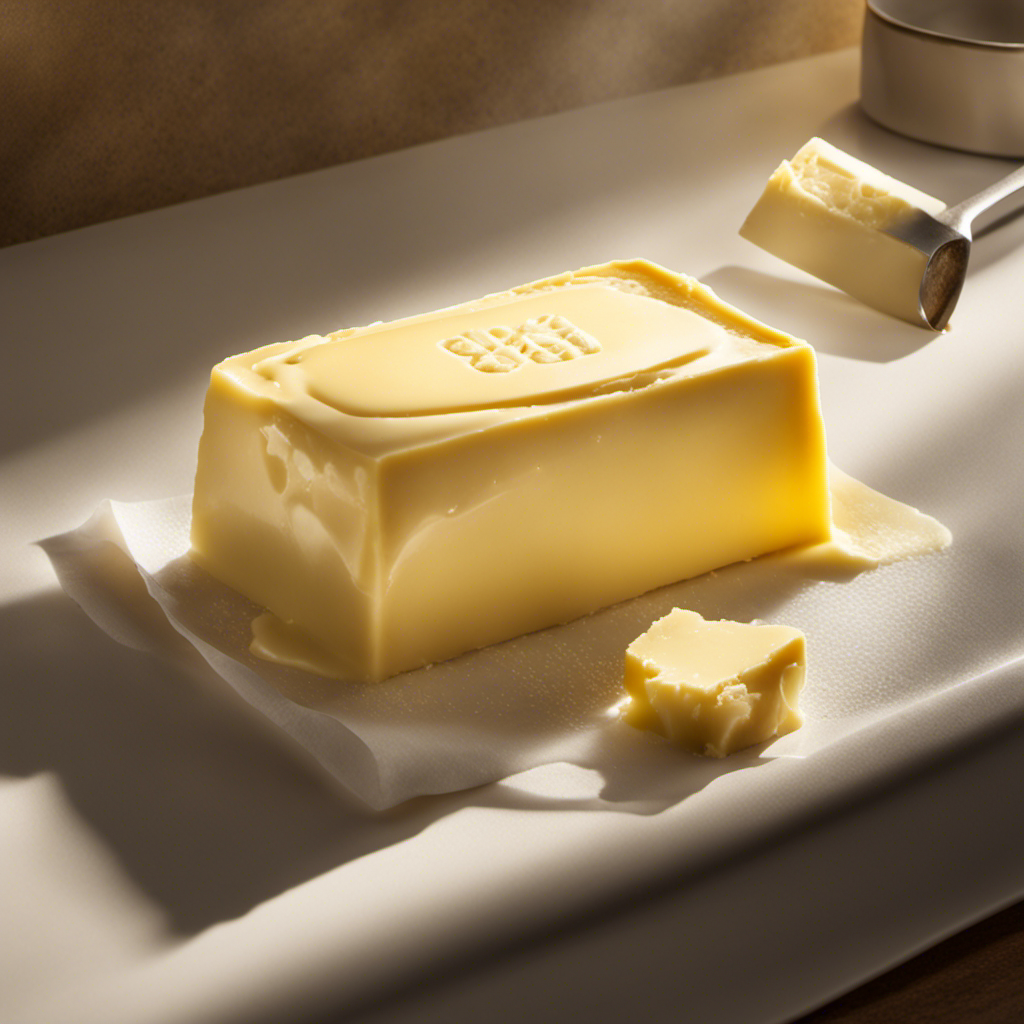Like they say, ‘all good things must come to an end.’ This is also true for cannabis butter. But just how long does this delightful creation last?
In this article, I will dive into the shelf life of cannabis butter, exploring the factors that affect its longevity and how to properly store it. We’ll also discuss ways to extend its lifespan and even whether it’s safe to use expired cannabis butter.
So, let’s unravel the mysteries surrounding the shelf life of this cannabis-infused treat.
Key Takeaways
- Storage conditions, such as temperature, light, and moisture levels, significantly affect the shelf life of cannabis butter.
- Proper storage methods, including cool and dark places, airtight containers, and refrigeration or freezing, can help extend the shelf life of cannabis butter.
- High-quality cannabis and butter can result in a more potent and longer-lasting product.
- Proper decarboxylation process is crucial for maximizing potency and extending the shelf life of cannabis butter.
The Shelf Life of Cannabis Butter
You might be wondering how long your cannabis butter will last. The shelf life of cannabis butter depends on several factors affecting freshness and maximizing potency.
One of the key factors is storage. Proper storage can significantly extend the shelf life of cannabis butter. It’s important to store it in an airtight container, away from light, heat, and moisture. Additionally, refrigeration or freezing can help preserve its freshness and potency for longer periods.
Another factor is the quality of the starting material. Using high-quality cannabis and butter will result in a more potent and longer-lasting product.
Finally, the decarboxylation process, which activates the cannabinoids, plays a crucial role in maximizing potency and extending the shelf life of cannabis butter.
Understanding these factors will help you make the most out of your cannabis butter and ensure its longevity.
Now, let’s explore the various factors affecting the longevity of cannabis butter.
Factors Affecting the Longevity of Cannabis Butter
When it comes to the longevity of cannabis butter, understanding the impact of storage conditions is crucial. Factors such as temperature, light exposure, and moisture levels can significantly affect the shelf life of this product.
Determining the shelf life of cannabis butter requires considering various determinants, including the quality of the ingredients used, the manufacturing process, and the presence of any preservatives.
To prevent butter spoilage, it is essential to store it in a cool, dark place, tightly sealed and away from moisture to maintain its freshness and potency.
Storage Conditions’ Impact
The shelf life of cannabis butter can be affected by storage conditions, such as temperature and humidity. Proper temperature and humidity control are crucial for maintaining the longevity of cannabis butter.
High temperatures can cause the butter to melt, leading to spoilage and a loss of potency. On the other hand, low temperatures can cause the butter to become too firm and difficult to use.
Humidity, or the amount of moisture in the air, can also impact the quality of cannabis butter. Excess moisture can promote the growth of mold and other microorganisms, while overly dry conditions can result in the butter becoming brittle and losing its potency.
Therefore, it is important to store cannabis butter in a cool, dry place, ideally in an airtight container, to ensure its freshness and effectiveness over time.
Shelf Life Determinants
Proper storage conditions, such as temperature and humidity, play a crucial role in determining the shelf life of cannabis butter. Shelf life variations can occur depending on how well the butter is stored. To better understand the impact of different storage conditions, let’s take a look at the table below:
| Storage Condition | Shelf Life |
|---|---|
| Cool and dry | 3-6 months |
| Refrigerated | 6-12 months |
| Frozen | 1-2 years |
| Exposed to light | 1-3 months |
| Exposed to air | 2-4 months |
Preserving potency is essential when it comes to cannabis butter. Exposure to light and air can degrade the cannabinoids present in the butter, leading to a shorter shelf life and decreased potency. Therefore, it is recommended to store cannabis butter in a cool, dry place, away from light and air, to extend its shelf life and maintain its potency for as long as possible.
Preventing Butter Spoilage
Storing cannabis butter in a cool and dry place helps prevent spoilage and maintains its potency. To ensure the freshness and longevity of your cannabis butter, follow these guidelines:
-
Use airtight containers: Oxygen can degrade the quality of cannabis butter. Store it in a tightly sealed container to minimize exposure to air.
-
Keep it away from light: Light can degrade cannabinoids in cannabis butter. Store it in a dark place, such as a pantry or cupboard, to preserve its potency.
-
Avoid temperature fluctuations: Fluctuations in temperature can cause the butter to spoil faster. Keep it in a cool, consistent environment to prevent spoilage.
-
Don’t introduce contaminants: Always use clean utensils and avoid touching the butter with dirty hands to prevent the growth of bacteria and mold.
How to Properly Store Cannabis Butter
When it comes to storing cannabis butter, it is important to understand the optimal storage conditions and the expected shelf life.
As a cannabis enthusiast and researcher, I have delved into the scientific evidence surrounding this topic. By exploring the factors that affect the longevity of cannabis butter, we can discover the best practices for storage and ensure that our product remains fresh and potent for as long as possible.
Optimal Storage Conditions
To keep your cannabis butter fresh, make sure you store it in a cool and dark place. Here are the best storage methods to ensure prolonged freshness:
-
Temperature control: Keep your cannabis butter at a temperature below 70°F (21°C) to prevent it from melting or spoiling. Avoid exposing it to direct sunlight or heat sources.
-
Air-tight container: Store your cannabis butter in an air-tight container to prevent oxidation and moisture from affecting its quality. This will help maintain its potency and flavor for a longer period.
-
Refrigeration: If you want to extend the shelf life of your cannabis butter, consider storing it in the refrigerator. The colder temperature will slow down the degradation process and keep it fresher for a longer time.
-
Freezing: For even longer storage, you can freeze your cannabis butter. Make sure to wrap it tightly in freezer-safe packaging to prevent freezer burn and maintain its freshness and potency.
Shelf Life Expectancy?
The shelf life of cannabis butter can be extended by following proper storage methods. Maximizing the shelf life of cannabis butter is important to ensure its potency and quality are maintained over time. When storing cannabis butter, it is crucial to keep it in an airtight container and store it in a cool, dark place. Exposure to air, light, and heat can degrade the cannabinoids in the butter, leading to a decrease in its potency. Additionally, it is recommended to label the container with the date of preparation to keep track of its freshness. By following these storage methods, the shelf life of cannabis butter can be maximized, allowing you to enjoy its benefits for an extended period.
Now, let’s discuss the signs of spoiled cannabis butter.
Signs of Spoiled Cannabis Butter
If you see any mold or a foul smell coming from your cannabis butter, it’s time to throw it out. Proper storage is key to ensuring the longevity and quality of your cannabis-infused butter.
Here are some tips to help you keep your butter fresh and avoid spoilage:
-
Temperature control: Store your cannabis butter in an airtight container in the refrigerator to prevent bacterial growth and maintain its potency.
-
Avoid moisture exposure: Moisture can lead to mold growth. Make sure your butter is completely dry before storage and avoid condensation by sealing the container tightly.
-
Keep it away from light: Light can degrade the cannabinoids in your butter. Store it in a dark and cool place, such as a pantry or a refrigerator drawer.
-
Check for signs of rancidity: Rancid butter has a distinct off smell and taste. If you notice any unpleasant odor or taste, it’s best to discard the butter to avoid any potential health risks.
Extending the Lifespan of Cannabis Butter
Storing cannabis-infused butter in an airtight container in the refrigerator helps preserve its freshness and prolong its shelf life. The cool temperature of the refrigerator slows down the degradation process, ensuring that the butter retains its potency for a longer period. Additionally, the airtight container prevents exposure to air, which can lead to oxidation and loss of potency.
To further extend the lifespan of cannabis-infused butter, it is essential to keep it away from light and heat, as these can accelerate the breakdown of cannabinoids. Therefore, storing the butter in a dark and cool place, such as the back of the refrigerator, is recommended.
It is important to note that even with proper storage, cannabis-infused butter will eventually lose its potency over time. Therefore, it is advisable to use it within a reasonable timeframe to ensure the best possible experience.
Using Expired Cannabis Butter
Using expired cannabis butter may not provide the desired effects due to the degradation of cannabinoids over time. Consuming expired cannabis butter can pose health risks and may lead to unpleasant experiences. Here are four important things to consider when using expired cannabis butter:
-
Decreased potency: Over time, the cannabinoids in cannabis butter break down, resulting in a decrease in potency. This means that the desired therapeutic or recreational effects may not be achieved.
-
Unpleasant taste: As cannabis butter expires, it can develop a rancid or off-putting taste. This can make it less enjoyable to consume and may affect the overall experience.
-
Potential for microbial growth: Expired cannabis butter may harbor harmful bacteria or fungi that can cause foodborne illnesses. It is important to properly store and handle cannabis butter to minimize the risk of contamination.
-
Inconsistent effects: The degradation of cannabinoids in expired cannabis butter can lead to inconsistent effects. This means that the potency and psychoactive properties may vary, making it difficult to predict the outcome of consumption.
Considering these factors, it is crucial to use fresh cannabis butter to ensure optimal effects and minimize potential health risks. Transitioning into the next section, let’s explore some frequently asked questions about the shelf life of cannabis butter.
Frequently Asked Questions About Cannabis Butter’s Shelf Life
One common question people have is how to determine the freshness of cannabis butter.
As a cannabis enthusiast, I have done extensive research on this topic and can provide evidence-based information.
To preserve the freshness of cannabis butter, proper storage is crucial. Store it in an airtight container in the refrigerator to prevent exposure to air, light, and moisture. This will help to maintain its potency and prevent the growth of harmful bacteria.
Additionally, it is essential to label the container with the date of preparation, as cannabis butter generally has a shelf life of about 2 to 3 months when refrigerated. Beyond that timeframe, the potency may decrease, and the butter may develop an off taste.
Frequently Asked Questions
Can I Freeze Cannabis Butter to Extend Its Shelf Life?
Yes, you can freeze cannabis butter to extend its shelf life. Freezing helps preserve the potency and freshness of the butter. There are also alternative methods like refrigeration or using a vacuum sealer to preserve cannabis butter.
What Is the Best Temperature to Store Cannabis Butter?
The best way to store cannabis butter is in an airtight container in the refrigerator. It is important to keep it at a consistent temperature, preferably around 35-40°F, to maintain its potency and freshness.
Can I Use Cannabis Butter That Has Been Stored for Over a Year?
I wouldn’t recommend using expired cannabis butter. Consuming old cannabis butter may pose health risks. It’s important to prioritize safety and ensure that the products we use are fresh and within their recommended shelf life.
How Can I Tell if My Cannabis Butter Has Gone Bad?
To prevent cannabis butter from going bad, store it in an airtight container in the refrigerator or freezer. Signs of spoilage include mold, off smell, or an unpleasant taste. Always check for these signs before using.
Can I Use Cannabis Butter That Has a Slightly off Smell or Taste?
I wouldn’t risk it. Expired cannabis butter can affect the taste and quality of your baked goods. Leaving it out overnight increases the chances of bacterial growth. It’s best to use fresh, properly stored butter for the best results.
Conclusion
In conclusion, it is important to store cannabis butter properly to ensure its longevity and freshness. By following the recommended storage methods, such as keeping it in an airtight container in the refrigerator or freezer, you can extend its shelf life.
However, just like any other food product, cannabis butter does have a limited lifespan. It is crucial to check for signs of spoilage before using it. Think of cannabis butter like a delicate flower that requires gentle care and attention to maintain its optimal state.










